Unwanted compounds such as dirt, rust, or iron in well water can cause it to turn an unsettling shade of brown. Brown well water is not only unsightly but can also pose a health risk.
While many residential houses rely on public city water, as many as 23 million US families use private wells for their water. Private wells are not subject to the same testing and treatment procedures as city water, meaning a higher chance of contamination.
If you notice brown discoloration in your water, it may be unsafe to use. The root cause needs to be found and treated before consumption.
Here’s a tabular view of causes & solution:
| Brown Water Cause | Sign | Solution |
|---|---|---|
| Rusty Pipes | Brown water from a particular faucet, Visible rusty pipes. | Replace Pipes |
| Iron Ore Buildup | Iron taste & odor, Stained clothes during laundry | Get an iron filter system (Our recommendation: Springwell ULTRA) |
| Iron Bacteria Buildup | Thick & slimy water, Brown-reddish buildup in well | Shock well or use chemical injection system (Our recommendation: Springwell Injection System) |
| Dirt and Debris in Wells | Debris in water at bottom of cup | Get a sediment filter or Tannins removal system with water softener (e.g Springwell Tannins System) |
| Septic Runoff | Septic tank is close to your well | Change position of your well (i.e build a new well) |
Why Is My Well Water Brown All of a Sudden?
In a nutshell, your well water is brown due to either rusty plumbing, bacteria growth or iron ore buildup in the well.
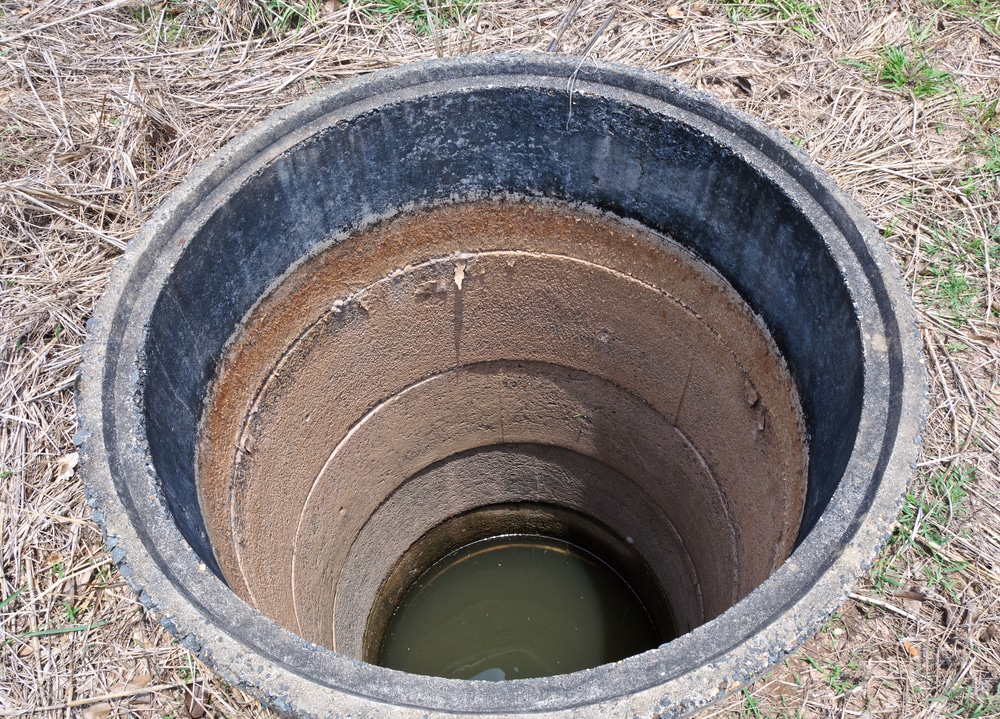
1. Rusty Plumbing Can Cause Brown Well Water
Rust, or iron oxide, is a common issue in older plumbing systems, especially those with cast-iron pipes. If you notice brown water coming from only one faucet, rusty pipes the likely culprit.
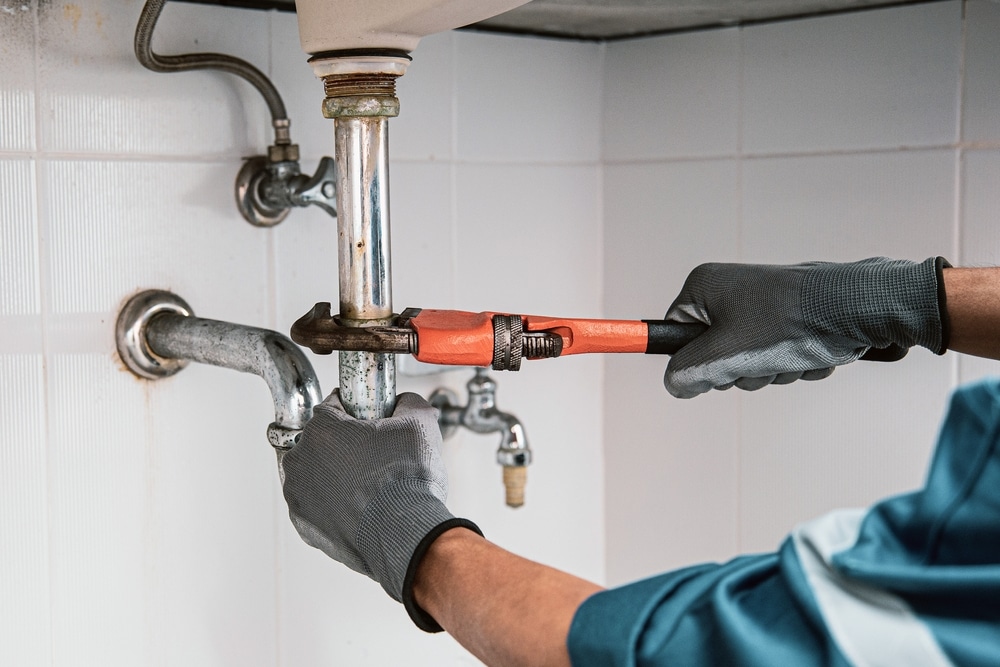
Over time, using rusty pipes, appliances, and fixtures will lead to brown water. Discoloration can also happen more quickly with heavy rainfall as the influx of water can mix with rust and wash into your well.
Brown hot water coming from a faucet may indicate a problem with your water heater. Older heater models are prone to inner rusting, especially with poor or infrequent maintenance.
2. Iron Ore Buildup In Well Can Affect the Water
In addition to iron oxide in older pipes, iron ore can build up inside the well and lead to water discoloration. Iron ore enters your water supply via surrounding streams, soil, and aquifers. Heavy rain can also flush added environmental contaminants into your well.
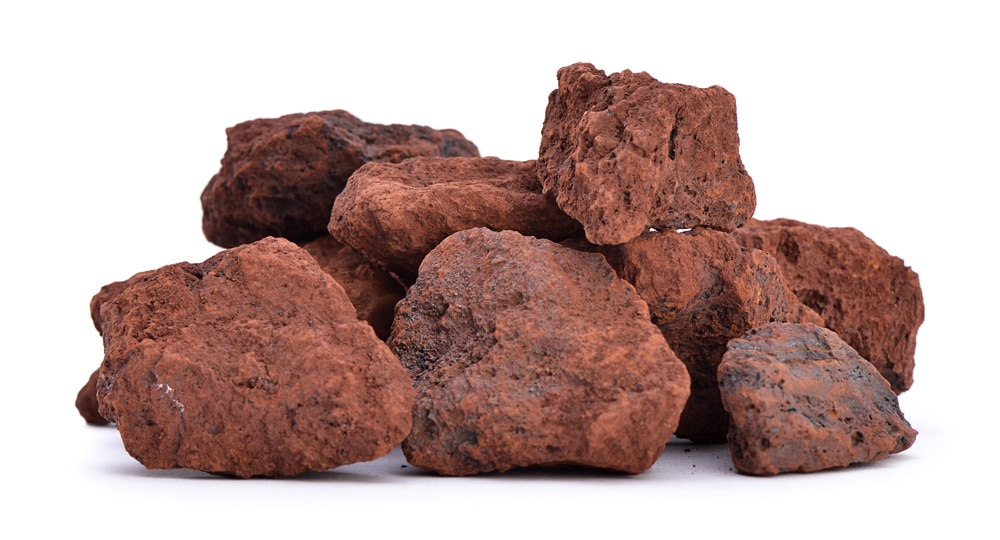
Rust is ferric iron in its oxidized form. It tends to have a more reddish hue than ferrous iron ore, a type of dissolved iron that causes darker, murkier discoloration in water.
Unlike rust, iron ore is easy to detect in tap water, thanks to its strong taste and odor. Ferrous iron ore in water can also permanently stain clothing if used in the washer.
To remove iron in water, you need a water filtration system built specifically for iron removal. A good example is the Springwell ULTRA well system which is majorly an iron filter system but also comes with a whole house carbon filter and salt-free water softener.
3. Iron Bacteria Growth in Well Can Cause Brown Water
In some cases, you may notice a brownish-red buildup sticking to the walls of your well. While this might look like rust, it is actually a buildup of iron bacteria.

Iron bacteria deposits will be thick, slimy, and generally stick to plumbing walls. Bacterial colonies don’t cause any known diseases, but can encourage the growth of more dangerous germs. The buildup can also impact water flow in pipes.
The best way to get rid of iron bacteria in wells is to either shock the well (with chlorine concentration) or use a chemical Injection system to continuously feed chlorine (calcium hypochlorite or liquid sodium hypochlorite) into the well using a chlorinator pump. We recommend the Springwell Chemical Injection system for this purpose.
4. Dirt and Debris In Wells Can Cause Water To Be Brown
In some cases, brown water can also be the result of sediment buildup in your plumbing. Dirt, silt, and especially tannins can make their way into your well particularly after heavy rain.
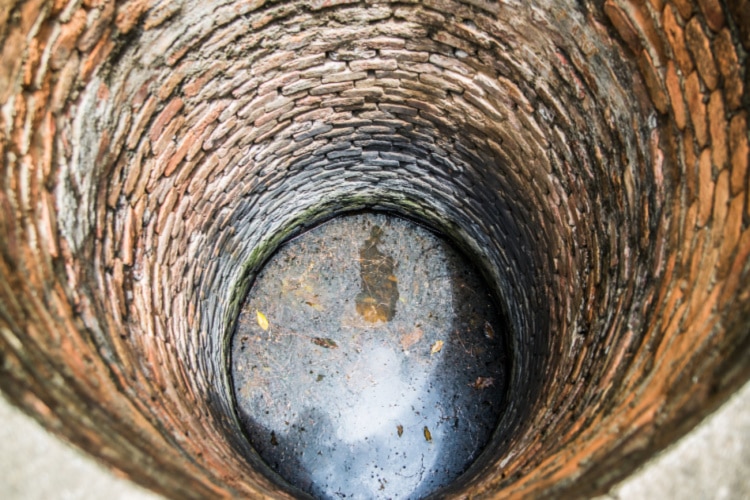
Letting the water inside the well sit stagnant for a while may also lead to debris buildup. After turning the system back on, you may notice that your water turns brown for a brief period before clearing.
The best way to determine whether discoloration is due to sediment is by allowing a glass of tap water to sit undisturbed. If you have debris in your water, it should separate and settle at the bottom of the cup.
5. Brown Well Water Might Be Caused By Septic Runoff
If your house has a septic system instead of city sewers, it may be the reason why your water is brown. A malfunctioning septic system may leak fluid into the groundwater. Tanks located too close to your well run a specifically high risk of cross-contamination.
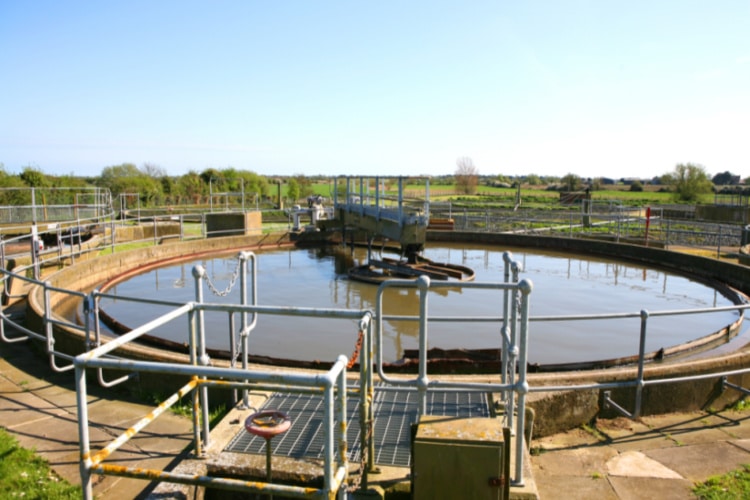
Septic cross-contamination of drinking and bathing water is incredibly dangerous. It can foster a wide variety of viral, bacterial, and parasitic diseases, some of which can be deadly.
Water that’s contaminated by means of septic runoff can be particularly toxic for young children, elderly adults, and immunocompromised individuals.
How To Get Rid of Brown Water in Wells
| Brown Water Cause | Solution |
|---|---|
| Rusty Pipes | Replace Pipes |
| Iron Ore Buildup | Get an iron filter system (Our recommendation: Springwell ULTRA) |
| Iron Bacteria Buildup | Shock well or use chemical injection system (Our recommendation: Springwell Injection System) |
| Dirt and Debris in Wells | Get a sediment filter or Tannins removal system with water softener (e.g Springwell Tannins System) |
| Septic Runoff | Change position of your well (i.e build a new well) |
The first step in tackling any kind of contamination or discoloration problem is to identify the source by either testing the water or hiring the services of a professional plumber.
Having identified the source, you can get rid of the issue by using a water softener, installing a filtration system, replacing old, rusted pipes, and making sure that your well isn’t close to a septic tank.
Here’s a step-by-step guide on how you should proceed:
Step 1: Test Your Well Water
The first step is to do a chemical analysis of your water. Water testing kits can identify which contaminants are present in your well water.
You can find DIY water testing kits online or at your local home supply store. Some kits test for specific contaminants such as iron; others offer a broader range of targets such as dissolved chemicals, bacteria, and pH levels. Make sure you get the most suitable one for your well.
For more accurate results, you may want to send your well water to an independent lab for analysis or contact your local health department for home water testing. A certified laboratory can test for uncommon or trace contaminants as well. Most testing institutions will also tell you the concentration of different impurities so you can come up with a more effective treatment solution.
Step 2: Choose a Treatment Solution Based on Your Test
Once you know the cause of your brown well water, you can work on treating it. There are a wide variety of solutions you can try depending on the test results:
1. Remove Brown Well Water by Using a Tannins & Water Softener System
Water with high levels of dissolved minerals such as calcium and magnesium is known as hard water. Hard water is also subject to contamination by compounds such as rust, which give water a brown coloration. Therefore, if tests show that your brown water is the result of impurities such as rust or iron, installing a water softener & tannins removal system for your well may help.
Water Softeners use ion exchange to remove mineral buildup in water. Not only does this leave water tasting better, but it can also prevent pipes, tanks, and heaters from rusting and subsequently, the water from discoloring.
2. Install a Filtration System For Your Well
A water softener will remove mineral impurities, but it may not tackle issues such as silt and soil or bacterial growth.
You can remove large sediment from your water by using a particulate filter. If your brown water comes from surrounding dirt and debris, a particulate filter should help to restore water purity.
Air injection filtration systems rely on oxidation to remove minerals such as iron and manganese from water. However, they don’t remove organic or sedimentary impurities.
3. Chlorinate Your Well To Remove Brown Water
If your well water is brown due to bacterial growth, chlorination can help to kill unwanted bacteria colonies, as it’s one of the most conventional and persistent water disinfection methods. Preemptive chlorination after heavy rains might prevent microbial and bacterial contamination through soil and debris as well.
Shock chlorination, though, is one of the best ways to deal with advanced bacterial growth in your well. It’s a process of disinfecting water by using ordinary bleach, and it’s best to use chlorine bleach containing 5% or more sodium hypochlorite to get the best results out of shock chlorination. However, note that the chlorine residue might give water a weird taste, color, and odor after the disinfection process. So, you might want to remove chlorine from water once it’s disinfected.
4. Contact Professionals
If septic runoff is the cause of this arduous problem, you should immediately contact a professional water treatment expert. They’ll thoroughly analyze your water supply and septic system and come up with a new plan to prevent further occurrences if need be.
Sometimes, having your well cleaned and installing a capable filtration system might be the solution. However, depending on the severity of the issue and the state your well is in, there are also cases when constructing a new well is the only solution.
That said, the CDC (Centers for Disease Control and Prevention) recommends having your well checked and tested annually by professionals. Even if you’ve installed all the best filtration systems, it’s also good to follow their recommendation.
In addition, if the problem stems from a rusty plumbing system, you need to call a plumber. They’ll identify which pipes are rusty and replace them.
Step 3: Retest Your Well Water After Treatment
Once your water is clean and clear again, it is time to retest for hidden contaminants. Even water that looks pure to the naked eye can contain dangerous impurities and toxins.
Similar to the process in the first step, you could do it either by yourself using a suitable test kit or hiring professional services.
If you’re not happy with the taste of your water, you may want to consider treating it a second time to ensure you remove all unwanted impurities.
Frequently Asked Questions
Heavy rain can flush dirt & contaminants into your plumbing system and lead to brown discoloration. Rain can also wash dirt, sediment, and even septic runoff into pipes, resulting in the same outcome.
Rust and mineral buildup are very likely to occur in older pipes due to prolonged exposure to minerals in hard water. A water softener & tannins removal system installed at the point of entry can help.
Moreover, replacing copper, steel, or iron pipes with corrosion- and rust-resistant PVC ones might prevent further issues.
If the solution to the problem at hand is installing a softener or filtration system, the cost is likely to be in the $1000-$4,000 range, depending on the quality and strength of the system.
However, if the solution requires you to replace the whole pipes in your house, expect to spend anywhere between $2,000-$15,000. Obviously, this will depend on the number of pipes that need to be replaced and the material their replacements are made of.
The worst-case scenario, though, is having to construct a new well. In this case, your expenses may run as high as $20,000. Of course, the depth and width of the well you want to construct will also affect that number.
How fast your well water clears up depends on the solution you implement.
Adding a filter to your plumbing setup can clear brown water in a matter of hours. For larger systems, it could take a few days to clear out impurities.
Chlorination will take 30 minutes to disinfect water from contaminants. However, seeing its effects on faucets might take a bit longer.
Septic runoff or rusty plumbing, on the other hand, might take a little while, depending on the severity of the issue and the responsiveness and pace of professionals.
It’s never a good idea to risk drinking brown water. At best, water containing contaminants such as iron ore is likely to taste foul. At worst, brown water can harbor dangerous diseases from septic runoff. So, always err on the side of caution and avoid drinking discolored water.
While you shouldn’t drink brown water, bathing or showering is most likely safe.
Contaminants such as dirt and rust may look unsightly, but they are unlikely to cause any damage to your skin.
However, you should still avoid getting brown water in your eyes or mouth to be safe. Moreover, bathing in water that’s already dirty might as well defeat the purpose of bathing.
Also read similar article: How to Get Rid of Brown Toilet Water (Easy Solutions)
we have brown water in a new well
It really helped when you said that there might be a leak from the septic system when the water well appears to be brown, and it happens when the tank or its components malfunctions. With that in mind, it would be best to hire a water well drilling company to check the issue if we are in that kind of situation in the future. My husband and I plan to invest in that for our property so that we can save money in the long run by reducing our monthly expenses due to having another source.
A few months ago, we moved to a house with a water well, and this morning, we noticed that our water looks brown. We’re glad you described the possible causes of brown water, so we’ll read this carefully while we look for a professional to inspect our well. We appreciate your information on iron oxide buildup and how it’s found in old pipes.